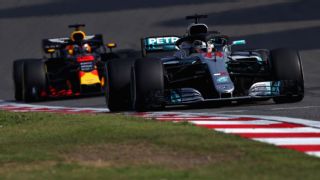|
Mercedes has explained why it did not pit Lewis Hamilton under the Safety Car at the Chinese Grand Prix -- a strategy that ultimately saw Red Bull's Daniel Ricciardo win the race. A switch to fresh soft tyres under the Safety Car allowed Ricciardo to move from sixth place to the lead in just ten laps following a series of daring overtaking manoeuvres on rivals with older tyres. Although Valtteri Bottas, who was leading the race when the Safety Car was deployed, was beyond the pit lane entrance and therefore unable to switch to softs at the same time as the Red Bulls, the option was open to Hamilton who was running fourth. With the benefit of hindsight, a stop may have allowed Hamilton to challenge for a podium or the win, but Mercedes' chief strategist James Vowles insists the tyre change did not make sense at the time. "The situation across the race to that point was that cars weren't really overtaking even when there was a difference in compound between them," Vowles explained in a YouTube video. "On stint one of the race you had a mixture of cars on soft and medium, no-one was overtaking each other. We had Kimi in front [of Hamilton] on the soft tyre and no difference between the two cars -- we couldn't even get close.  "Same for Valtteri at the front relative to Vettel. But those were obviously on the same tyres. Verstappen was on that ultra-soft tyre, a tyre that was very sensitive and very difficult, and neither Kimi nor Lewis could make any inroads into him at all. So on a track like that the performance difference between compounds wasn't working out. "Under Safety Car conditions we always review how many positions we can potentially gain, and how many positions we may lose. So first of all, what would we have gained? Verstappen ahead, we knew there was a chance they would come in with the Safety Car, and if that were to happen, it would put Lewis back up into a podium position, if we can take that medium to the end of the race and defend against those cars behind us. "Now, the medium on our car was working very, very well. Indeed, we knew that you could do 40 laps on it, which is what you saw at the end of the race with Valtteri, that tyre was working at the end of the race. So the first question is, is a 10-lap old medium going to suffer? The next question is, how many positions are we going to lose behind us? "We knew Ricciardo was in our window, so if he didn't stop, we'd drop behind him. But furthermore we had Kimi, and Kimi had stayed out very, very long, and he was back into what we call the safety car window for Lewis -- which meant it would be very, very marginal if Lewis was going to come out in front or behind Kimi. "What you saw was both Red Bulls took that opportunity, and in fact Ricciardo did end up behind Kimi, Verstappen ended up ahead. With Lewis we also knew that if we stopped under the Safety Car, we would always be behind Verstappen -- so whatever happened we would be behind Verstappen going through the race from then onwards." But Vowles admitted his team did not expect the soft tyre to be so competitive at the end of the race, hence why it prioritised track position over a tyre change. "It was a decision that when we laid out all the facts on the table, we didn't believe, based on the earlier evidence, that there would be enough performance differential for a soft to overtake a medium, even one that's 10 laps old. "The reality of the situation is that everyone saw what happened - both Red Bulls were extraordinarily quick on that tyre and were able to just scythe through the field, making their way up to the front."
|
